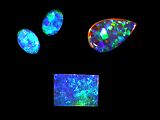![]()
Name:
Opal

Chem:
SiO2-n(H2O)
hydrated silica
Crystal:
Isomorphic (no crystal structure)
Color:
yellow, clear, blue, gray, (all with or without color flash)
Refrac. Index:
1.44 - 1.46
Birefraction:
none
Hardness:
5.5 - 6.5
Spec. Grav.:
1.98-2.20
Fracture:
conchoidal
Cleavage:
none
Environment:
opal is a low temperature mineral and is found in cracks or cavities that are filled in late in their geological life. Water , must be present. It is also found as a replacement after certain skeletons of marine animals or plants.
Association:
often in porous substrates
Locals:
| Australia | Calif., Nev., Idaho, USA | Mexico | Brazil | Hungary |
Misc:
The name is probably from the Latin "opalus", meaning "precious stone". Opal can easily be dehydrated by heat or chemical exposure. Is very porous and can be damaged by many chemicals.
Opal has been duplicated in the laboratory, and the material provides a very close approximation to the natural material. It is produced by the controlled (very slow) precipitation, and alignment of small silica spheres. The spheres form a three dimensional diffraction pattern which produces the color play.
Beside synthetic opal there are also some opal "simulants" on the market. A simulant is something that resembles the natural material, but is composed or produced in an entirely different way. One such simulant is "Slocum Stone", and appears to be a variety of glass. (See Synthetics for more man-made stones.)
Gem info:
Opal has a variety of poor gemstone characteristics, softness, dehydration, cracking, physical weakness, and sensitivity to heat. It also shows one of the best spectral displays of any gemstone, hence its value. It is made up of layers of precipitated silica spheres in a jelly-like water mass, and the ordering of the spheres sometimes produce a diffraction grating, that creates a play of rainbow sparkling light from within the stone.
There are fundamentally three types of opal: precious opal (containing flashes of fire), the yellow-reddish "fire opal" which is named for its color (not flashes of fire), and common opal (sometimes called "potch").
"Common opal" is rarely transparent, but may be colored or contain inclusions. It is used as backing for the more desirable varieties of precious opal, but may also be cabbed to produce interesting stones. It comes in white, gray, yellow, blue, green, pink, and may be dendritic or contain moss.
"fire opal" is named for its fiery red color, and not the flashes from within. Today most fire opal comes from Mexico and is often cut into faceted gem stones. It runs from a deep red to many shades of orange and even on to yellow. It may have a few flashes of fire, but usually it is sold for the color and clarity. It is not particularly expensive as it suffers from the same physical characteristics as all opal, and contains little of the desired color flash.
"Precious Opal" - this is the material with the internal "color play", "flash", or "light show". It is classified by its back ground color, the particular colors and intensity of color display, and its size. Stones that are predominantly white or light blue are the most common, and those that contain reds, oranges, and violets are considered more desirable. Blue and green are very common in most precious opal. Black opal, opal containing a predominantly dark background (dark-gray to blue-black) is the rarest, and most desired of all opals. When it contains reds and oranges it brings even a higher value. It may be priced right up with the top gemstones (diamond, emerald, and ruby). The very best black opal came from Lightening Ridge. Australia and small amounts till reach the market today, but there have been no major finds in many years.
Another "collectors" variety is called "contra luz". It shows the desired play of color, but only when light is transmitted through the stone. It appears to be clear when viewed from the same side. It is thus very difficult to design jewelry using this variety and it finds its way mainly into collections. "Hydrophane" is a variety that losses its water to become opaque, but can regain it's water and become transparent with color flash, again mainly a collectors stone.
Opal Doublets and Opal Triplets - these are sandwiched stones made up of 2 or more pieces. Further information is provided.